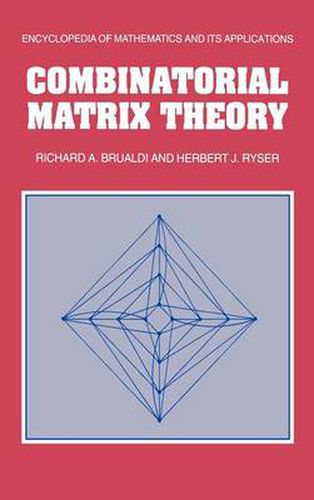Readings Newsletter
Become a Readings Member to make your shopping experience even easier.
Sign in or sign up for free!
You’re not far away from qualifying for FREE standard shipping within Australia
You’ve qualified for FREE standard shipping within Australia
The cart is loading…






This is the first book devoted to the exposition of combinatorial matrix theory. This subject concerns itself with the use of matrix theory and linear algebra in proving results in combinatorics (and vice versa), and with the intrinsic properties of matrices viewed as arrays of numbers rather than algebraic objects in themselves. There are chapters dealing with the many connections between matrices, graphs, digraphs and bipartite graphs. The basic theory of network flows is developed in order to obtain existence theorems for matrices with prescribed combinatorial properties and to obtain various matrix decomposition theorems. Other chapters cover the permanent of a matrix, and Latin squares. The final chapter deals with algebraic characterizations of combinatorial properties and the use of combinatorial arguments in proving classical algebraic theorems, including the Cayley-Hamilton Theorem and the Jordan Canonical Form. The book is sufficiently self-contained for use as a graduate course text, but complete enough for a standard reference work on the basic theory. Thus it will be an essential purchase for combinatorialists, matrix theorists, and those numerical analysts working in numerical linear algebra.
$9.00 standard shipping within Australia
FREE standard shipping within Australia for orders over $100.00
Express & International shipping calculated at checkout
This is the first book devoted to the exposition of combinatorial matrix theory. This subject concerns itself with the use of matrix theory and linear algebra in proving results in combinatorics (and vice versa), and with the intrinsic properties of matrices viewed as arrays of numbers rather than algebraic objects in themselves. There are chapters dealing with the many connections between matrices, graphs, digraphs and bipartite graphs. The basic theory of network flows is developed in order to obtain existence theorems for matrices with prescribed combinatorial properties and to obtain various matrix decomposition theorems. Other chapters cover the permanent of a matrix, and Latin squares. The final chapter deals with algebraic characterizations of combinatorial properties and the use of combinatorial arguments in proving classical algebraic theorems, including the Cayley-Hamilton Theorem and the Jordan Canonical Form. The book is sufficiently self-contained for use as a graduate course text, but complete enough for a standard reference work on the basic theory. Thus it will be an essential purchase for combinatorialists, matrix theorists, and those numerical analysts working in numerical linear algebra.